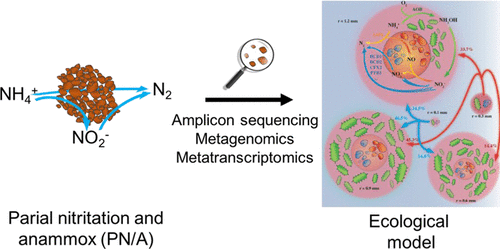当前位置:
X-MOL 学术
›
Environ. Sci. Technol.
›
论文详情
Our official English website, www.x-mol.net, welcomes your
feedback! (Note: you will need to create a separate account there.)
Larger Anammox Granules not only Harbor Higher Species Diversity but also Support More Functional Diversity
Environmental Science & Technology ( IF 10.8 ) Pub Date : 2020-10-29 , DOI: 10.1021/acs.est.0c02609 Hui Chen 1, 2 , Tao Liu 1 , Jie Li 1 , Likai Mao 1 , Jun Ye 3 , Xiaoyu Han 4 , Mike S. M. Jetten 5 , Jianhua Guo 1
Environmental Science & Technology ( IF 10.8 ) Pub Date : 2020-10-29 , DOI: 10.1021/acs.est.0c02609 Hui Chen 1, 2 , Tao Liu 1 , Jie Li 1 , Likai Mao 1 , Jun Ye 3 , Xiaoyu Han 4 , Mike S. M. Jetten 5 , Jianhua Guo 1
Affiliation

|
Granule-based partial nitritation and anammox (PN/A) represents one of the most energy-efficient biotechniques for ammonium removal from wastewater. The PN/A granules appear in a continuum of sizes, yet little is known about the extent to which microbial communities and microbial metabolisms are partitioned between size-fractionated granules. Here, we divided granules harvested from a pilot-scale PN/A reactor into five discrete size fractions (<0.2, 0.2–0.5, 0.5–0.8, 0.8–1.0, and >1.0 mm). The composition and functional attribute of five pools of the size-fractionated granules were characterized by 16S ribosomal RNA (rRNA) gene amplicon and metagenomic and metatranscriptomic sequencing to provide a comprehensive insight into the key microbial group in a PN/A system. Larger granules were shown to not only harbor higher microbial diversity but also support more diverse functions than smaller granules. De novo coassembly and binning of metagenomic reads yielded 22 draft genomes of dominant microorganisms, which allowed us to infer an ecological model of the microbial ecosystem in anammox-based granules. This genome-based ecological model indicates that nitrifying organisms in smaller granules feed nitrite to anammox bacteria in larger granules. The results improve our understanding of the PN/A system, especially for the metabolic interactions between small and large granules.
中文翻译:

较大的厌氧氨氧化颗粒不仅具有更高的物种多样性,而且还支持更多的功能多样性
基于颗粒的部分硝化和厌氧氨氮(PN / A)是从废水中去除铵的最节能生物技术之一。PN / A颗粒以连续的大小出现,但人们对微生物群落和微生物代谢在大小分级的颗粒之间分配的程度了解甚少。在这里,我们将中试规模的PN / A反应器中收获的颗粒分为五个离散的大小部分(<0.2、0.2-0.5、0.5-0.8、0.8-1.0和> 1.0 mm)。通过16S核糖体RNA(rRNA)基因扩增子以及宏基因组和元转录组测序来表征5个大小分级的颗粒池的组成和功能属性,以全面了解PN / A系统中的关键微生物群。与较小的颗粒相比,较大的颗粒不仅具有更高的微生物多样性,而且还支持更多的功能。从头开始的宏基因组组装和装箱产生了优势微生物的22个基因组草图,这使我们能够推断出基于厌氧氨氧化颗粒的微生物生态系统的生态模型。这种基于基因组的生态模型表明,较小颗粒中的硝化生物将亚硝酸盐供入较大颗粒中的厌氧细菌。结果提高了我们对PN / A系统的理解,特别是对于小颗粒和大颗粒之间的代谢相互作用。这使我们能够推断出基于厌氧氨氧化颗粒的微生物生态系统的生态模型。这种基于基因组的生态模型表明,较小颗粒中的硝化生物将亚硝酸盐供入较大颗粒中的厌氧细菌。结果提高了我们对PN / A系统的理解,特别是对于小颗粒和大颗粒之间的代谢相互作用。这使我们能够推断出基于厌氧氨氧化颗粒的微生物生态系统的生态模型。这种基于基因组的生态模型表明,较小颗粒中的硝化生物将亚硝酸盐供入较大颗粒中的厌氧细菌。结果提高了我们对PN / A系统的理解,特别是对于小颗粒和大颗粒之间的代谢相互作用。
更新日期:2020-11-17
中文翻译:

较大的厌氧氨氧化颗粒不仅具有更高的物种多样性,而且还支持更多的功能多样性
基于颗粒的部分硝化和厌氧氨氮(PN / A)是从废水中去除铵的最节能生物技术之一。PN / A颗粒以连续的大小出现,但人们对微生物群落和微生物代谢在大小分级的颗粒之间分配的程度了解甚少。在这里,我们将中试规模的PN / A反应器中收获的颗粒分为五个离散的大小部分(<0.2、0.2-0.5、0.5-0.8、0.8-1.0和> 1.0 mm)。通过16S核糖体RNA(rRNA)基因扩增子以及宏基因组和元转录组测序来表征5个大小分级的颗粒池的组成和功能属性,以全面了解PN / A系统中的关键微生物群。与较小的颗粒相比,较大的颗粒不仅具有更高的微生物多样性,而且还支持更多的功能。从头开始的宏基因组组装和装箱产生了优势微生物的22个基因组草图,这使我们能够推断出基于厌氧氨氧化颗粒的微生物生态系统的生态模型。这种基于基因组的生态模型表明,较小颗粒中的硝化生物将亚硝酸盐供入较大颗粒中的厌氧细菌。结果提高了我们对PN / A系统的理解,特别是对于小颗粒和大颗粒之间的代谢相互作用。这使我们能够推断出基于厌氧氨氧化颗粒的微生物生态系统的生态模型。这种基于基因组的生态模型表明,较小颗粒中的硝化生物将亚硝酸盐供入较大颗粒中的厌氧细菌。结果提高了我们对PN / A系统的理解,特别是对于小颗粒和大颗粒之间的代谢相互作用。这使我们能够推断出基于厌氧氨氧化颗粒的微生物生态系统的生态模型。这种基于基因组的生态模型表明,较小颗粒中的硝化生物将亚硝酸盐供入较大颗粒中的厌氧细菌。结果提高了我们对PN / A系统的理解,特别是对于小颗粒和大颗粒之间的代谢相互作用。















































 京公网安备 11010802027423号
京公网安备 11010802027423号